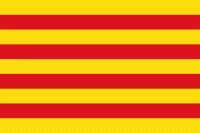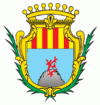Alghero
 |
 |
The population is noted for having retained the language of the Catalan rulers from the end of the Middle Ages, when Sardinia was part of the Crown of Aragon; hence, Alguerese (the Catalan dialect spoken there) is officially recognized as a minority language.
Alghero is the third university center in the island, coming after Cagliari and Sassari. It hosts the headquarters of the Università degli Studi di Sassari's Architecture and Design department. In 2012 it was the 10th most visited city by tourists in Italy.
The area of today's Alghero has been settled since pre-historic times. The Ozieri culture was present here in the 4th millennium BC (Necropolis of Anghelu Ruju), while the Nuraghe civilization settled in the area around 1,500 BC.
The Phoenicians arrived by the 8th century BC and the metalworking town of Sant'Imbenia – in the area of later Alghero –, with a mixed Phoenician and Nuragic population, engaged in trade with the Etruscans on the Italian mainland.
Due to its strategic position on the Mediterranean Sea, Alghero had been developed into a fortified port town by 1102, built by the Genoese Doria family. The Dorias ruled Alghero for centuries, apart from a brief period under the rule of Pisa between 1283 and 1284. Alghero's population later grew because of the arrival of Catalan colonists. In the early 16th century, Alghero received papal recognition as a bishopric and the status of King's City (ciutat de l'Alguer) and developed economically.
Historically, the city was founded in the early twelfth century between 1102 and 1112, when the noble Doria family of Genoa was allowed to build the first historical nucleus into an empty section of the coast of the parish of Nulauro in Judicature of Torres (Sassari). For two centuries it remained in the orbit of the Maritime Republics, first and foremost the Genoese, apart from 1283 to 1284 when the Pisans were able to control it for a year. It is plausible that at this time the town shared, given its commercial and multi-ethnic nature, a language similar to the nascent Sassarese.
The village was conquered by force by the Crown of Aragon, at the behest of King Pere III of Aragon (r. 1336–1387), who later actively promoted colonisation of the town and the surrounding area, sending numerous families from different counties and provinces of the then Crown of Aragon, including Valencia, Majorca, Catalonia and Aragon. These were granted enticing privileges and, in fact, replaced the original population, some of whom were sent to the Iberian Peninsula and Majorca as slaves. The dialects these families spoke in Alghero were all very similar and derived from the same linguistic family. Over time, it settled on its current form of Catalan, despite the subsequent decline of the Crown of Aragon.
The Aragonese were followed by the Spanish Habsburgs, who ruled until 1702 and continued expanding the town. In 1720, Alghero, along with the rest of Sardinia, was handed over to the Piedmont-based House of Savoy, upon the arrival of which a policy of Italianization was commenced. In 1821, a famine led to a revolt by the population, which was bloodily suppressed. At the end of the same century, Alghero was de-militarised.
During the Fascist era, part of the surrounding marshes were reclaimed and the suburbs of Fertilia and S.M. La Palma were founded. During World War II (1943), Alghero was bombed, and its historical centre suffered heavy damage. The presence of malaria in the countryside was finally overcome in the 1950s.
Map - Alghero
Map
Country - Italy
 |
 |
| Flag of Italy | |
Italy was the native place of many civilizations such as the Italic peoples and the Etruscans, while due to its central geographic location in Southern Europe and the Mediterranean, the country has also historically been home to myriad peoples and cultures, who immigrated to the peninsula throughout history. The Latins, native of central Italy, formed the Roman Kingdom in the 8th century BC, which eventually became a republic with a government of the Senate and the People. The Roman Republic initially conquered and assimilated its neighbours on the Italian peninsula, eventually expanding and conquering a large part of Europe, North Africa and Western Asia. By the first century BC, the Roman Empire emerged as the dominant power in the Mediterranean Basin and became a leading cultural, political and religious centre, inaugurating the Pax Romana, a period of more than 200 years during which Italy's law, technology, economy, art, and literature developed.
Currency / Language
| ISO | Currency | Symbol | Significant figures |
|---|---|---|---|
| EUR | Euro | € | 2 |
| ISO | Language |
|---|---|
| CA | Catalan language |
| CO | Corsican language |
| FR | French language |
| DE | German language |
| IT | Italian language |
| SC | Sardinian language |
| SL | Slovene language |















